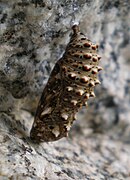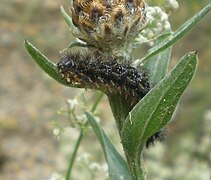Melitaea phoebe
- View a machine-translated version of the French article.
- Machine translation, like DeepL or Google Translate, is a useful starting point for translations, but translators must revise errors as necessary and confirm that the translation is accurate, rather than simply copy-pasting machine-translated text into the English Wikipedia.
- Do not translate text that appears unreliable or low-quality. If possible, verify the text with references provided in the foreign-language article.
- You must provide copyright attribution in the edit summary accompanying your translation by providing an interlanguage link to the source of your translation. A model attribution edit summary is
Content in this edit is translated from the existing French Wikipedia article at [[:fr:Mélitée des centaurées]]; see its history for attribution. - You may also add the template
{{Translated|fr|Mélitée des centaurées}}to the talk page. - For more guidance, see Wikipedia:Translation.
| Knapweed fritillary[1] | |
|---|---|
 | |
| Male | |
 | |
| Female | |
Conservation status | |
 Least Concern (IUCN 3.1)[1] | |
| Scientific classification | |
| Domain: | Eukaryota |
| Kingdom: | Animalia |
| Phylum: | Arthropoda |
| Class: | Insecta |
| Order: | Lepidoptera |
| Family: | Nymphalidae |
| Genus: | Melitaea |
| Species: | M. phoebe |
| Binomial name | |
| Melitaea phoebe | |
| Synonyms[1] | |
| Papilio phoebe Denis & Schiffermüller, 1775 | |
Melitaea phoebe, also known as the knapweed fritillary,[1] is a butterfly of the family Nymphalidae.[2] It is found in the Palearctic realm, including most of Europe and north Africa, excluding the UK and Scandinavia. Previously, it also included Melitaea telona, which was recently revalidated as a distinct cryptic species[citation needed].
Description
Melitaea phoebe has a wingspan of 34–50 mm. The forewing is much more pointed than in the previous species but equally variable in both colour and distinctive markings. The black markings are usually united, in some cases even covering nearly the whole wing, but in other cases may be strongly reduced. A characteristic feature of this species is the reddish yellow submarginal lunate spot situated between the two median veins that reaches with its vertex considerably farther into the disc than the other yellow lunate spots. This is especially the case on the forewing, but also on the hindwing. The submarginal lunule between the 1 and 2 median veins projects farther basal than the others of the same row.[3] Wheeler (1903) gives a short description.[4]
-
 Male
Male -
 Male underside
Male underside -
 Female
Female -
 Female underside
Female underside
-
 Pupa
Pupa -
 Larva
Larva -
 Larva
Larva
Biology
M. phoebe is active from April to September, depending on the location. The larvae feed on Plantago and Centaurea species (including Centaurea jacea).[citation needed]
Distribution and habitat
M. phoebe is present in Europe, except in the northern part: England, Ireland, Northern France, Germany, Poland and Scandinavia. It is also found in North Africa (Morocco and Algeria), Turkey, Siberia, and Central Asia (Mongolia and China)[citation needed].
M. phoebe lives in the flowery meadows[citation needed].
Etymology
Named in the classical tradition. Phoebe is - in Greek mythology - one of the first generation of Titans, who were one set of sons and daughters of Uranus and Gaia.[citation needed]
References

- ^ a b c d e Melitaea phoebe[permanent dead link]. IUCN Red List.
- ^ Savela, Markku. "Melitaea phoebe (Denis & Schiffermüller, 1775)". Lepidoptera and Some Other Life Forms. Retrieved 23 June 2018.
- ^ Seitz. A. in Seitz, A. ed. Band 1: Abt. 1, Die Großschmetterlinge des palaearktischen Faunengebietes, Die palaearktischen Tagfalter, 1909, 379 Seiten, mit 89 kolorierten Tafeln (3470 Figuren).
 This article incorporates text from this source, which is in the public domain.
This article incorporates text from this source, which is in the public domain. - ^ Wheeler, George. The butterflies of Switzerland and the alps of central Europe. London: Elliot Stock, 1903.



















